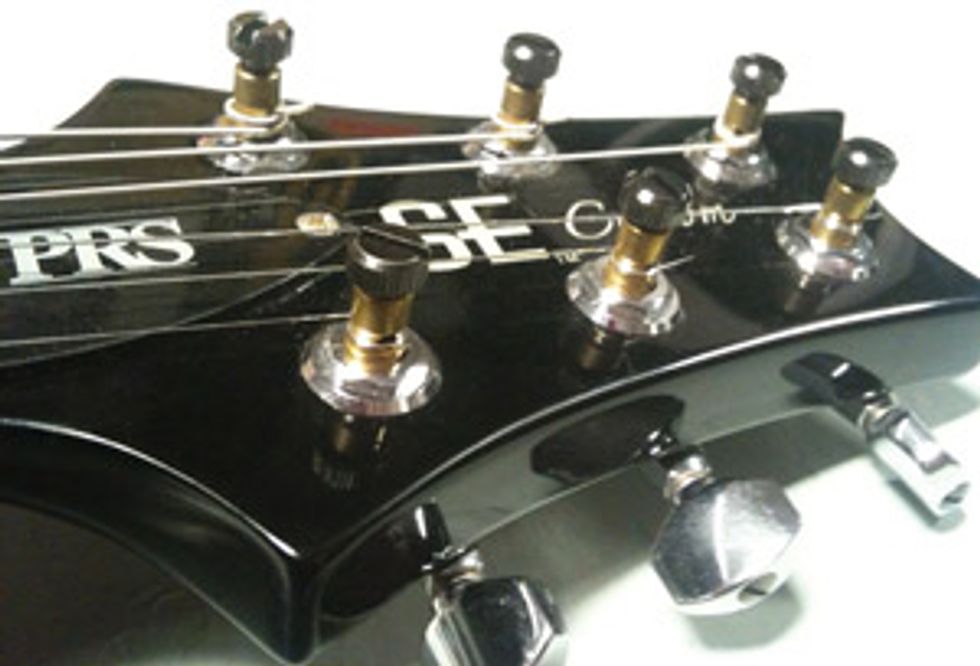Tuner design, mass, and material have an effect on tone.

Tuner design, mass, and material have an effect on tone. Replacing the stock tuners on this guitar with a set of low-mass locking tuners with brass cams yielded more highs and better sustain.
Playing a guitar that easily slips out of tune is like taking a flight with a lot of turbulence. Whether you’re a player or an audience member listening to poor tuning, or a passenger on the bumpy flight, the dissonance and turbulence can greatly interfere with your ability to enjoy the respective experience. In the sonic hierarchy, tuning is king and several of the elements that affect your tuning also affect your tone. Most tuning problems I’ve encountered are related to the string nut.
I’ve had the best luck, both tonally and tuning-wise, with nuts that are cut out of bone. Of all the materials I’ve experimented with, bone provides the most lively sound and feel, and is easy to mold and manipulate. If you have a guitar with a cheap plastic nut, upgrading to a bone nut will provide a significant sonic improvement. Plastic has a tendency to produce a “doinky” sound and muffled feeling. In the ’80s, solid brass string nuts were a popular choice among guitarists. Brass nuts have a pleasant brightness in their tonality, but I’ve found the material to be difficult to work with when setting the height of the string slots. Now, let’s address some issues associated with those string slots.
If you ever hear clicking and pinging sounds as you crank the tuning peg, chances are there is a burr or some foreign material in the slot that prohibits the string from moving smoothly. You can remedy this issue by lightly running an appropriately sized file through the slot. Also, string trees can cause tuning slippage and pinging sounds if they are bent out of shape.
Another classic fix to temporarily improve tuning involves applying a small amount of pencil lead in the string slots. Generally, this tactic is more successful on bone nuts than it is on plastic nuts. The lead acts as a dry lubrication for the string to easily glide over the nut slot. I asked my friend John LeVan, of LeVan’s Guitar Services in Nashville, about his thoughts on the old pencil lead trick and he told me that pencil lead is also useful to apply where the string rests on the bridge saddles.
When you install a new set of strings, you’ll want to make a quick checkup in a couple of areas. First, ever wonder what those little screws on your tuning pegs do? Not only do they change how easily the tuning peg turns, but they also ensure that the peg will not drift on its own. Check the screws and gently but securely tighten them to a uniform tension.
If you have locking tuners, make sure the cam collars are securely tightened. These collars play a big role in making sure the whole tuning mechanism doesn’t move around. Some people think that little things like the cam material don’t make a difference to the sound or feel of a guitar, but I disagree. I replaced the stock tuners on my PRS SE Custom Semi-Hollow with a set of low-mass PRS locking tuners with brass cams. The swap boosted the overall high end, added some glimmer and sparkle to the guitar’s sustain, and improved tuning.
Installing a quality string is also vital to well-tempered tuning and excellent tone. I know the lure of saving money by purchasing $2 packs of economy strings is appealing, but you can end up paying for it in bad tuning and shorter string life. Using strings from a reputable manufacturer pays off in the long run.
When it comes to installing your string of choice, there are several schools of thought on winding techniques, but they agree on two things: You want to keep the winds tightly grouped together on the post and you want to avoid string-on-string overlaps. When installed properly, a string should look like a Slinky toy that’s in a resting position. Personally, I like to put three to four winds on the post because I get a little more snarl and rumble out of the string that I don‘t get with fewer winds.
After you stretch your strings, always tune up to pitch whenever you tune. If a note is reading sharp on your tuner, make sure you dip below your desired pitch first and then raise the string back into the note. This will ensure that the tension is properly distributed and the string will be less subject to slippage.
If you’re interested in the system that’ll end all of your tuning problems for good, check out the EverTune bridge. It’s certainly one of the most revolutionary products in the history of the electric guitar. I don’t even take a tuner when I take a guitar with an EverTune to a show or session. (For more technical details, check out the company’s videos on evertune.com. But before you do, be fair warned that you’re going to have a hard time not shelling out the dough for one of these bridges once you see it in action.)
When I flip through the pages of PG, I’m always impressed by how many options we have as players to manipulate our guitar’s tone with different pickups, amps, pedals, and countless other components. We can swap and modify a wide range of parts, but the fact is, all of that is in vain if your guitar is out of tune. I encourage you to take the time to extensively research all the ways you can stabilize your instrument’s tuning so that unwanted dissonance won’t create any turbulence at your next gig.
